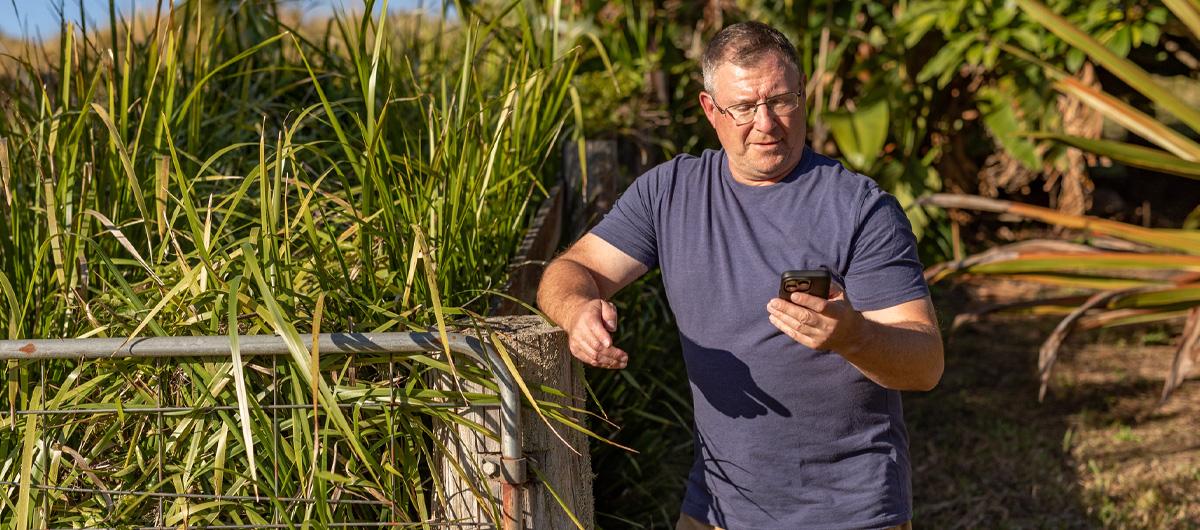Mission 4
Keep NSW safe and resilient during emergencies online and in-person.
Our goals
Climate change is expected to increase the frequency and intensity of natural disasters. We need to respond with proactive information and timely action to make sure people feel secure and supported before, during and after emergencies. Emergencies include natural disasters (floods and bush fires), physical emergencies (power and transport network outages and accidents), and online emergencies (cyber attacks against critical infrastructure, identity theft and ransomware).
In the wake of multiple fire and flood emergencies across NSW in 2022-23, Service NSW provided support at 178 Disaster Recovery Centres and recovery assistance points, as well as at mobile points and via council-led programs.² It delivered a range of flood assistance programs, receiving more than 99,000 grant applications and paying over $490 million to affected communities.² The Service NSW app provided impacted communities with timely and helpful information on how to find recovery support,² for example, giving about 370,000 people affected by floods an easy pathway to access the resources and support they needed.²
With more people getting their information online, NSW is committed to reliable network connectivity for timely information and notifications, enabled by inter-agency real-time information sharing and safeguarded by our cyber security capability. To ensure accessibility, alternative communication channels are also available.
Collaboration across government, industry and academia will further improve our ability to manage cyber risks. This ensures the continued confidentiality, integrity and availability of government systems and data.
To deliver timely, proactive and effective response management, we will:
4A: Support effective communication and connectivity for everyone during natural disasters and emergencies
4B: Make sure NSW services and communities are digitally safe and prepared
4C: Maintain modern, quality systems and interoperability across NSW Government agencies
4D: Strengthen cyber risk management to protect data
How we'll get there
4A: Support effective communication and connectivity for everyone during natural disasters and emergencies
In times of a disaster or emergency, all affected people in NSW should be able to access information and notifications. For people who are unable to connect online, we must provide available alternatives to digital channels.
It’s important that all people receive fast and effective information before, during and after a disaster or emergency. The NSW Government is expanding connectivity, including in regional and rural areas, to allow agencies to coordinate, share resources and respond in times of emergency and disaster.
For people who are unable to connect online, Service NSW has a strong presence across the state through service centres, council agencies, Mobile Service Centres and Disaster Recovery Centres.
42. Improve emergency response and coordination through development of a new emergency management operating system
43. Deliver secure and resilient critical communications for emergency services by expanding the Public Safety Network
45. Deliver secure and resilient critical communications to coordinate support and resources for telecommunications during emergencies
46. Deliver secure and resilient critical communications through network operations and enhancement
47. Lead connectivity innovation through community connectivity initiatives
- Trialing innovative new connectivity such as large area wi-fi to provide better coverage in remote areas and support first responders in emergency scenarios.
- Providing mobile broadband or satellite connectivity even when there is no Public Safety Network (PSN) coverage, through initiatives like the Vehicle as a Node (VaaN) technology which allows emergency service organisations to stay connected. NSW Telco Authority is working with NSW State Emergency Service (NSW SES) and Motorola to roll out VaaN technology, while a $69 million Rural Fire Service initiative will fit out more than 5,000 operational vehicles with this new technology over the next three years, including access to Starlink which uses low earth orbit (LEO) services.
- Supporting emergency response and recovery in areas with no coverage, through Cells on Wheels (CoWs) which are rapid response vehicles that provide power, radio and internet communications. This allows emergency services personnel to have the power and communications equipment they need to remain operational in difficult circumstances.
- Providing real-time fire risk information to communities via remotely operated digital signs, which are powered by solar panels and automatically updated each day in line with NSW fire danger rating signs.
- Providing notifications and warnings for floods, tsunamis, severe weather and fire in NSW with the Hazards Near Me app and Hazard Publisher. Delivered through the HazardWatch ecosystem, this has reduced emergency services warning times from 30 minutes to 3 minutes, saving lives and property.
- Eliminating the need for customers to resubmit their information to multiple government departments, while recovering from the impact of a disaster. The Tell Your Story Once initiative enables a more coordinated disaster recovery approach by securely sharing customer registration information, with consent, across NSW Government agencies.
- Supporting victims and survivors of domestic and family violence. The Digital NSW Accelerator team is working with the Department of Communities and Justice on the DV Notify app, which will provide real-time information to victims and survivors when a perpetrator leaves custody.
4B: Make sure NSW services and communities are digitally safe and prepared
Online threats pose a real-life impact to the people, communities, businesses and services of NSW. For example, an online threat can impact our hospitals or transport network. The NSW Government must remain vigilant and proactive in protecting systems, infrastructure and data against online threats.
Cyber Security NSW plays a key role in safeguarding the digital environment of the NSW Government by working closely with different agencies during all phases of managing cyber security risk, from preparation to recovery. The Government is committed to building a resilient cyber security strategy that takes a risk-based approach, adapts to evolving threats and protects sensitive information.
- Coordinating the NSW Government’s response to significant cyber incidents and crises through Cyber Security NSW, which coordinates all of government cyber security strategies and initiatives and delivers products, services and best-practice advice and guidance to agencies and local councils.
- Helping people navigate the aftermath of a data breach through ID Support NSW. This service supports NSW Government departments to respond to data breaches and notify affected individuals, shares free resources and tools with individuals, groups and businesses to protect against identity theft and data breaches, and helps people restore their stolen or misused identity documents.
- Promoting and protecting privacy and information access rights in NSW through the Information and Privacy Commission (IPC), an independent statutory authority.
- Requiring agencies to satisfy data management requirements, including maintaining an internal data breach incident register and having a publicly accessible data breach policy. Under the Mandatory Notification of Data Breach Scheme, agencies are now required to notify the Privacy Commissioner and affected individuals in the event of an eligible data breach of their personal or health information by a NSW public sector agency or state-owned corporation subject to the Privacy and Personal Information Protection Act 1998.
- Leading the Cybermarvel program, a joint initiative of the NSW Department of Education with the Victorian, Tasmanian, Australian Capital Territory, South Australian and Northern Territory education departments. The program aims to build staff and students’ cyber safety awareness and skills, inform parents and carers about how to keep their family safe online, and encourage safe and positive online behaviours and experiences.
4C: Maintain modern, quality systems and interoperability across NSW Government agencies
Interoperability is the ability for NSW agencies to have systems, applications and processes that enable information to be shared quickly and easily. Maintaining modern systems allows the NSW Government to create a more connected digital environment. Modern systems such as cloud-based services provide greater flexibility and scalability. Data can be shared more seamlessly through modern Application Programming Interfaces (APIs) and standards. This leads to better and more accurate information for the public sector to make better informed decisions.
- Enabling data driven decisions in local councils, businesses and industry and assisting agencies to address gaps through the development of the Connectivity Index which provides a suburb-level snapshot of connectivity in NSW.
- Fostering partnerships between NSW Government emergency services to share resources and enhance public safety. For example, the NSW Rural Fire Service (RFS) and Surf Life Saving NSW (SLSNSW) have teamed up to introduce aerial surveillance patrols of busy local beaches, to help keep the state’s northern coastline safer.
- The Connected Firefighter Program sees Fire and Rescue NSW committed to working with partner agencies, industry and government to integrate the latest information and communications technologies to improve critical fire safety communication, situational awareness and decision making for firefighters, other emergency agencies and our community.
- Coordinating critical communications between telecommunications carriers and Emergency Services Organisations (ESOs) through Telecommunications Emergency Management Unit (TEMU). The TEMU collects information, data and intelligence from many sources to produce real-time mapping and situational updates to frontline responders.
4D: Strengthen cyber risk management to protect data
Cyber security incidents can have a significant impact on people, businesses and communities across NSW. Protecting government and community data is critical in protecting the security and safety of our state and its people.
To advance cyber security, products and services should be secure by design. We must regularly review and update our systems so that policy and training are aligned with emerging cyber threats.
To do this, we’ll continue to work closely across government, industry and academia. By increasing collaboration, the NSW Government can more quickly address complex issues arising from a fast-changing digital landscape.
40. Update the NSW Cyber Security Strategy
41. Assess agency compliance with mandatory NSW Cyber Security Policy
44. Lead connectivity innovation through community connectivity and testing deployable broadband products
- Managing evolving cyber risks effectively through the NSW Cyber Security Policy, which sets clear standards and guidelines for government agencies. The policy was updated in early 2024 with a new reporting methodology requiring agencies to submit annual reporting on the mandatory requirements to Cyber Security NSW. This enables a better understanding of NSW Government’s cyber maturity and helps prioritise resources.
- Safeguarding NSW Government email domains from cyber threats and fraud. Domain-based message authentication, reporting and conformance (DMARC) authentication allows only authorised individuals to send emails using the legitimate NSW Government domain.
- Helping people restore their identity securely and prevent identity theft through ID Support NSW. They have helped over 35,000 customers with complex identity remediation, sent 150,000 data breach notifications and provided training to over 16,000 people across NSW.
- Advising NSW Government agencies and staff on safe and responsible AI use in the workplace through the Cyber Security NSW generative AI end-user guide.
- Uplifting cyber security skills to better protect NSW Government systems and data. Cyber Security NSW delivers a suite of cyber security awareness training across NSW Government and councils through both e-modules and live sessions, training more than 210,000 staff in the 2023-24 financial year.
Make digital services accessible, inclusive and connected for everyone in NSW
Use digital to improve service delivery, support the local economy and drive productivity
Underpin trust in government through reliable, stable digital services and sustainable Digital Infrastructure
Uplift digital capability in the public sector workforce



